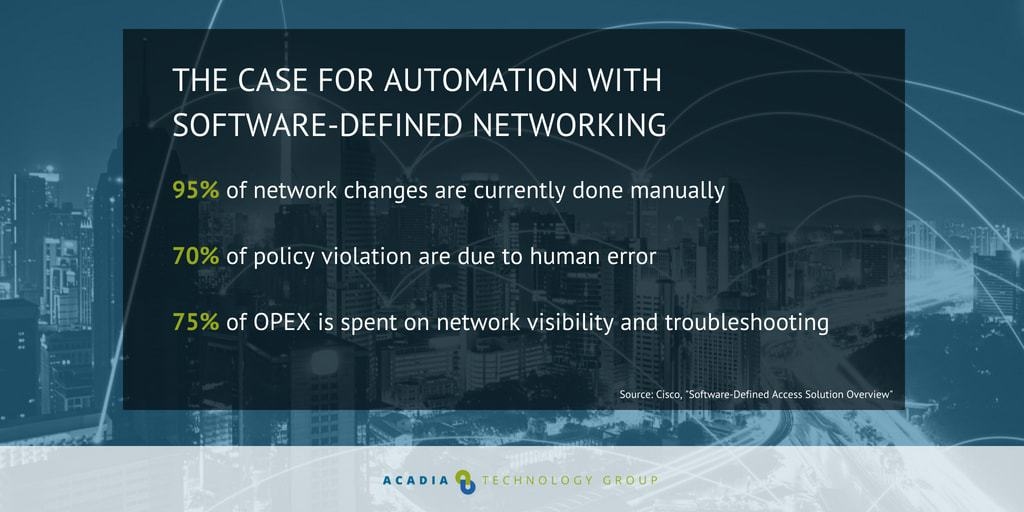
The movement to creating Smart Factories through manufacturing automation and streamlined data exchange is changing the way things are being made, and software-defined networking is at the forefront of network technologies enabling this transformation.
Industrial IoT (IIoT), machine to machine (M2M), the cloud, wired and wireless networks and the expanding network edge of a global supply chain are now requirements for competitive manufacturing. The IDC Manufacturing Predictions 2018 study says that by 2020, 60 percent of G2000 manufacturers will rely on digital platforms that support 30 percent of overall revenue.
Manufacturers working to increase productivity in this new global manufacturing economy are realizing that the goal of fast and agile data throughput and access must be balanced with proactive security and compliance.
In this type of evolving manufacturing landscape, networking is the linchpin for achieving those possibilities. Manufacturers can do this by introducing digital transformation holistically from the factory floor to beyond the network edge.
Software-Defined Network (SDN) is emerging as the ideal solution for meeting the needs of manufacturing. However, SDN for manufacturing enterprises only becomes a clear solution when you understand how it can be applied to address the evolving challenges and pain points across an expanding manufacturing ecosystem.
The Challenges of Transitioning to Smart Factories
According toCisco, 95 percent of network changes are manual in nature, 70 percent of policy violations are due to human error, and 75 percent of OPEX is spent on network visibility and troubleshooting. Slow and error-prone manual network configuration and fragmented tool offerings are clearly the main challenge to a responsive and agile network in a digital world where:
- Network switch deployments and software upgrades take hours
- Application deployment, access and monitoring are time, resource, and cost-intensive
- Security and policy concerns with proprietary data in transit to and from the cloud as well as within wired and wireless networks leaves evolving points of vulnerability
- The manufacturing environment and broader supply chain are constantly changing and evolving with more users, devices and applications
- Consistent policy between increasing wired and wireless in-network devices and users add complexity and vulnerabilities to credentialing and access configurations
- Finding and troubleshooting network issues becomes more difficult and error-prone
- Bandwidth issues across the network and to the cloud create latency problems that affect network performance
Consequently, it’s important to have a way to integrate internal visibility of production processes and networking with external supply chain operations and logistics. The solution must be infinitely agile to enable real-time changes relevant to the manufacturing cycle while eliminating the network silos of IT and operational technology (OT). SDN for manufacturers can deliver the convergence of data-centric computing of IT with OT’s event, process, and device monitoring. This enables simplified adjustments in enterprise and industrial operations.
Benefits of SDN in Manufacturing
IIoT and sensor technology are crucial to manufacturing by tying critical operational and control data from shop floor equipment and robotics to product and materials movement, vehicle fleets, and material handling systems. This data is constantly being produced and directed through wired and wireless IT/OT networks and the cloud to beyond the network edge.
Because of the global economy, supply chain management requires agile network provisioning, routing, and monitoring for cost containment and logistical agility. This is the only way to accurately manage the expanding internal systems, applications and devices that produce and run on big data while integrating the many disparate corporate, manufacturing and third-party partners. SDN solutions help manufacturers manage the global supply chain in real time by seamlessly tying production and operations of the factory floor to:
- Enterprise Resource Planning (ERP), Material Requirements Planning (MRP) and Warehouse Management Systems (WMS) through Integration with machine learning, IIoT, and Robotic Process Automation (RPA)
- Shipping, logistics, channel partners, distributors and retail for making real-time adjustments and forecasting based on need, inventory and scheduling changes
- The ability to make real-time routing and provisioning changes across network access points
- Meet dynamic data bandwidth needs across IT/OT
- The enablement of more dynamic pricing or adjustments to cash positions based on real-time visibility of operations
- Data visibility and actionable use through appropriate architecture, IoT security, advanced network tools and predictive analytics
- Mobility solutions for troubleshooting and reviewing production lines on the go and supporting an increasingly diverse portfolio of applications and users
- Robust, cost-effective and fault tolerant infrastructure
- Overall Equipment Effectiveness (OEE) analysis for improvements in your internal and external supply chains
- Agile and predictive on-demand bandwidth that connects teams and applications across time zones in real-time via glitch and stutter-free video conferences and mobile devices
Application and Security Benefits of SDN
Today, applications and their access determine if manufacturing entities can support given initiatives. Manufacturers must be able to build such applications, make them agile, deploy them globally and make them securely available to end users. Software-defined networking for manufacturers can meet all of these needs.
Your manufacturing environment also presents an expanding list of cybersecurity threats through machine and device connectivity as well as data and application access in a potentially global ecosystem. As a consequence, the SDN network security impact extends to creating agile:
- Enterprise and Manufacturing Security Policies consisting of:
- Role Based Access Control
- Secure Group Tags on all devices
- Applying consistent security policies across the wired and wireless network
- Demilitarized Zone and Domains of Trust segmentation
- Firewalls to defend the manufacturing edge
- Interior protection and endpoint hardening
- Security Management, Analysis, & Response
- Real-time identity access management, adjustment and policy implementation
- Regulatory compliance, data governance activity and routing systems
Finally, SDN presents real cost-saving opportunities as traditional hardware and network design methodologies in manufacturing networks are unsustainable and incompatible with digital transformations.
Cisco’s SDN solution offerings can improve security, reduce operating expenditures, improve compliance and optimize the user experience. An SDN solution allows administrators to design the network, provision networking gear programmatically and enforce group-based policies to secure the network. Using role-based access control, white-listed users and devices can only access applications and resources they are explicitly given permission to access.
Beyond SDN to Intent-Based Networking
Today, SDN continues to evolve in ways that enable even greater network agility through cloud-based platforms that can deliver Intent-Based Networking (IBN). In general, IBN replaces manual configuration of switches, firewalls and other infrastructure components through the command-line interface (CLI) with automation and orchestration.
This new approach to SDN for manufacturers facilitates planning, design and automatic implementation of on-the-fly changes to the network for greater availability, agility, security, and reliability. An IBN solution using Cisco’s SDN technologies can enable true IT/OT convergence through segmentation that enables rapid creation, changes, monitoring, and deletion of network services as needed.
Ultimately these next-generation SDN solutions provide smarter end-to-end network control, automation, and service agility so that your manufacturing environment can quickly and easily meet IT and OT needs today and tomorrow. As a skilled and expert Cisco partner, Acadia Technology Group is ideally positioned to provide you with clarity and context for the usage of Cisco’s SDN solutions in your network.
To learn more about emerging security threats in 2018, download the free white paper.
